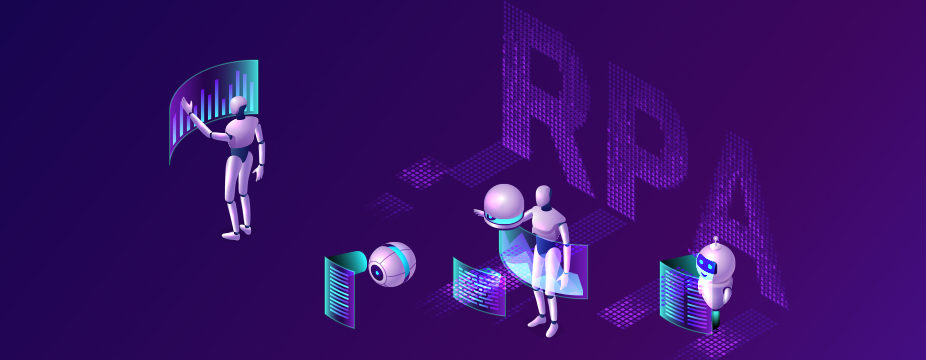|
Getting your Trinity Audio player ready...
|
Businesses are integrating automation technologies to enhance the existing systems to perform better operations and functions due to intensifying competition and squeezing revenues. In the wider picture, when businesses think about automation, AI-integrated technologies are at the forefront of deployment. According to the forester report, 40% of businesses automated their operations during their digital transformation journeys; to enhance their scalability, reliability, and efficiency. With the boost of automation, robotic process automation (RPA) has become part of the enterprise’s vision for reducing operational time and cost. The enterprises started to integrate AI with Robotic Process Automation for driving support in developing and enhancing RPA results.
What is AI-powered Robotic Process Automation?
Robotic process automation (RPA) is an integral part of the intelligent automation system. It defines the simulations of miscellaneous, repetitive, and routine tasks that are manually performed by humans. The RPA follows the same course of action on a system, that humans follow while performing a task. RPA is a highly customized software. And it performs with a certain type of process, which includes dreary or routine workflow. Sample of systems where RPA automation is required in accounting and finance.
Robotic process automation integrated with machine learning and natural language can harness unstructured, semistructured, and structured data over voice, manual, and text commands. These RPA-integrated systems are called cognitive robotic process automation. Advanced RPA systems are leveraged to perform Intelligent Process Automation.
How AI enhances RPA?
AI and RPA are two distinct terms. The term AI is the simulation of human intelligence by a machine. And the RPA system simulates the operations of a machine to perform the assigned tasks. RPA performs simple tasks that don’t require thinking, knowledge, and insights: which include coding, and performing -repetitive -and functional-computational tasks. AI integration helps RPA systems, to work as knowledge-based dynamic system-to work beyond an automated cognitive system.
AI-Powered Robotic Process Automation can drive better Business values
The AI-integrated RPA systems enhance business operations through data-driven analytics; These obtained insights improve the lifecycle and work time of employees to improve quality and accuracy at work. By integrating AI with RPA, a computer robot can carry out actions such as scraping, data aggregation, data cleaning, and communication tasks between simulated machines to reduce the working time into fractions. A business can leverage the RPA throughout every function that needs to perform manually on a system. Examples: finance and accounting, BPO, sales processes, CRM, and other miscellaneous works in a business environment.
-
1. Cost-effective business operation model:
Robotic process automation helps in performing repetitive and functional tasks at a fast pace. For instance, the robotic system can perform the task performed by humans in a fraction of a second, which consumes maximum time when manually performed. The RPA system reduces the time contributed by employees in performing manual tasks; to increase the speed of business operations. And to better revenues in the long run.
-
2. Improves quality and accuracy in work:
Most of the manual tasks performed in an organization are bound to have human errors, which reduces the quality and accuracy level of the work. For instance, copy-paste tasks, financial calculations, multitasking between windows to create financial credit accounts for customers, etc. And these tasks can consume time -and humans may commit minor mistakes- which reduces the quality and accuracy of work, in the end. The robotic system integrated with AI intelligence can mimic the tasks manually performed -and it can deliver the same result, with more accuracy.
-
3. Employee empowerment:
98% of the tasks performed by the RPA system are repetitive, functional, and derby. And in many organizations, skilled labor is utilized to perform tasks and operations. As 80% of the employees are uninterested in performing manual and repetitive tasks, contribute minimum effort. The deployment of AI with Robotic Process Automation at work to perform derby tasks- motivates employees to spend quality time performing challenging tasks. And it increases the growth and exposure of the organization.
-
4. Better control:
- The data-driven insights and analytics help control and monitor employee contribution toward the organization’s growth.
- RPA provides an advantage over manual decisions made by executives through fact-driven analysis of tasks performed.
-
5. Enhanced life cycle time:
The life cycle time of performing individual tasks can be reduced without compromising the quality of work. The scalability, reliability, and flexibility of machines can be increased by integrating RPA. And it adds more value to the business through optimized automation of manual tasks that require human presence.
Robotic process automation is at the early stages of deployment in many industries. And an AI with robotic process automation is leveraged by businesses either to perform repetitive and manual tasks or to build an intelligent automation system for the up-gradation of existing businesses. The BFSI and BPO industries are at the core of robotic process automation. And an AI integrated with the RPA system for automating internal communication channels and processes can upgrade industrial operation structure. And leveraging RPA benefits industries with complex business structures and how they operate crucial tasks that may win or lose customers’ trust.
In this article, we discussed RPA technology and how it can enhance the operations of an enterprise. If you resonate with our article, please share your thoughts with us.
If you need any help with idea validation, proof-of-concept, Data Science consulting, large-scale AI implementation, Big Data Engineering, or a creative solution for your business. You are at the right place.
Talk to our experts
